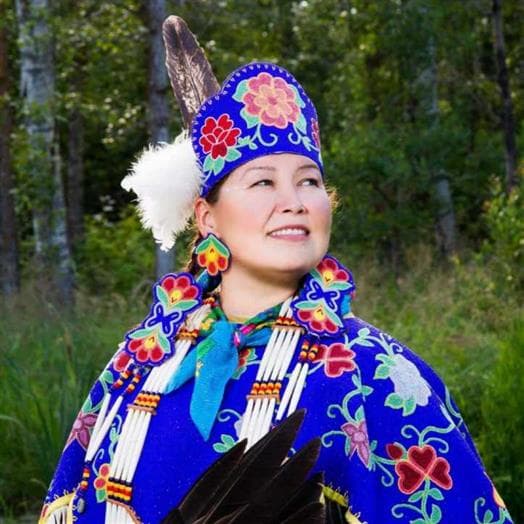Rosita Hirtle, of Dene descent from the Fort McKay First Nation, was raised doing beadwork and has been beading for over 40 years now. Her grandmother created beadwork on the moccasins and mukluks that she made for her grandfather who was a trapper. Rosita continues to pass on the knowledge. “I do it as a traditional teaching. Beading teaches us how to be patient and creative – it is a form of storytelling. Both of my kids bead. My son is a grass dancer and my daughter is a jingle dancer. They spend a lot of time beading during the winter, sometimes for extra money or for their regalia.”
Rosita’s designs are inspired both by her traditional culture as well as pop culture. “Dene beadwork is an inspiration. The different ways the flowers are drawn in our culture. Our different colours.” Rosita laughs, “but I’ve also made a phone grip of Yoda. I love the craft. I don’t even look at it as time. If I’m troubled or stressed, I just sit down and work on my beads. There’s an area at my kitchen table that is just for beading. No one sits in Mommy’s chair!”
Rosita sees beadwork, like other visual arts, as a way to contribute to healing and reconciliation. “Art gives notice, it gives recognition to a cause. It starts conversations. It’s something that people can point to and say ‘have you seen this?’ Art helps bring things to the surface. We need to talk about things (like MMIWG or Every Child Matters) so they aren’t forgotten. Healing starts with conversations.”
“Part of my spirituality teaches that we’re always learning; that we’re both student and teacher, all our lives. Some non-Indigenous people don’t know about the suffering of Indigenous people. And they don’t know about Indigenous culture, like the traditional teachings that are involved in beadwork. Even some Indigenous people who grew up in cities don’t fully know how the traditional Indigenous way of life has changed. Residential schools continue to have residual effects. It didn’t just impact the child, but the family – the siblings, their children, their grandchildren. Learning is the beginning of healing.”
This is one of the reasons that Rosita is happy to contribute to initiatives like Petro-Canada’s beaded logo project. “I’m impressed that Petro-Canada has asked beading artists to create different logos. It makes the public more aware of Indigenous issues. This is a valuable role that companies like Petro-Canada can play – helping to keep these issues top of mind.”





